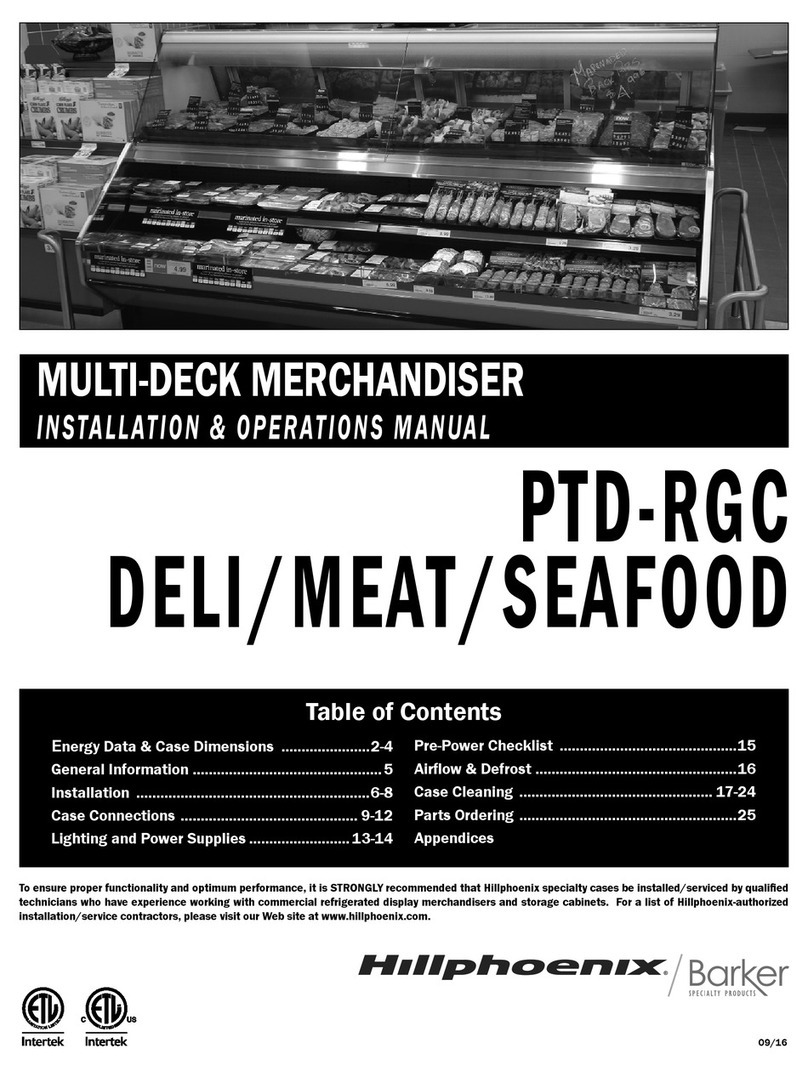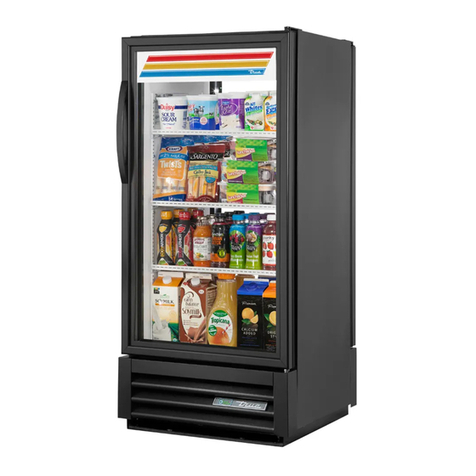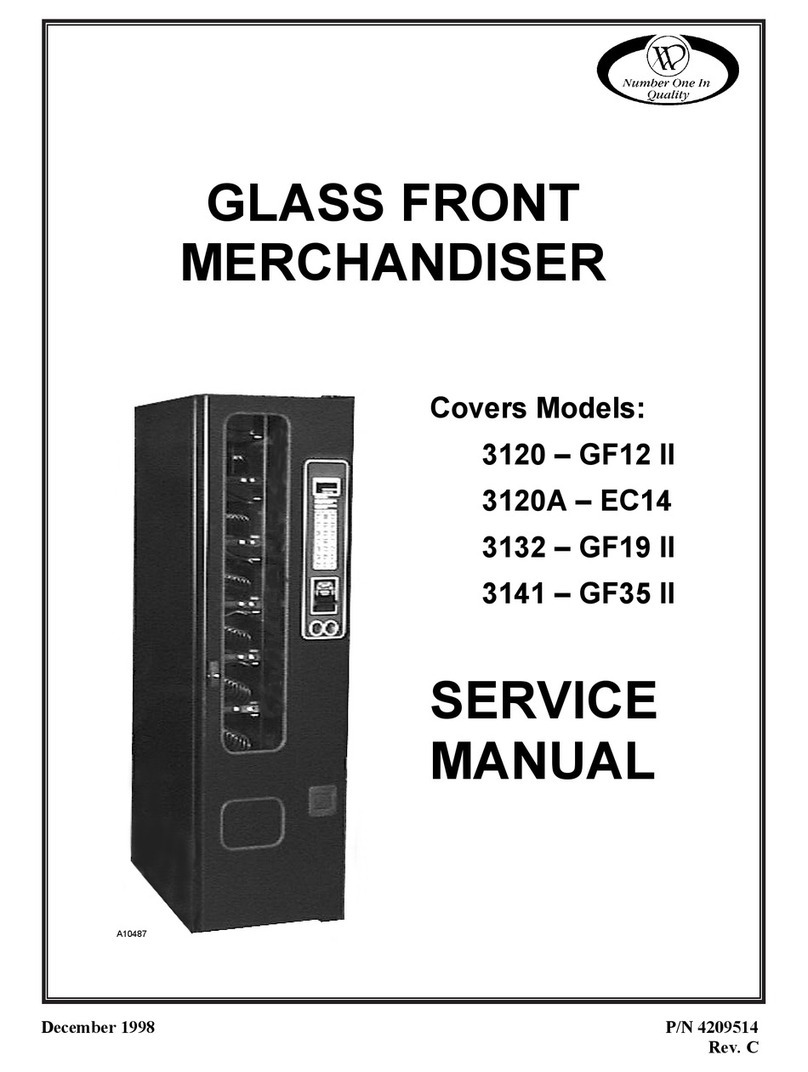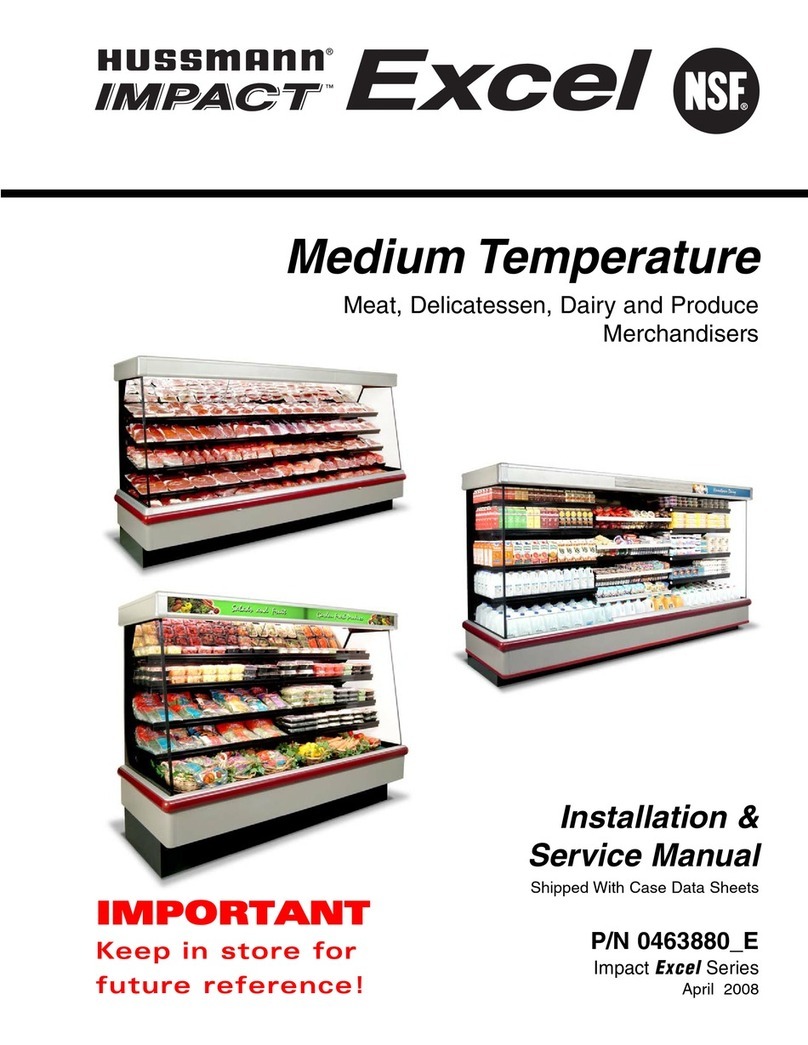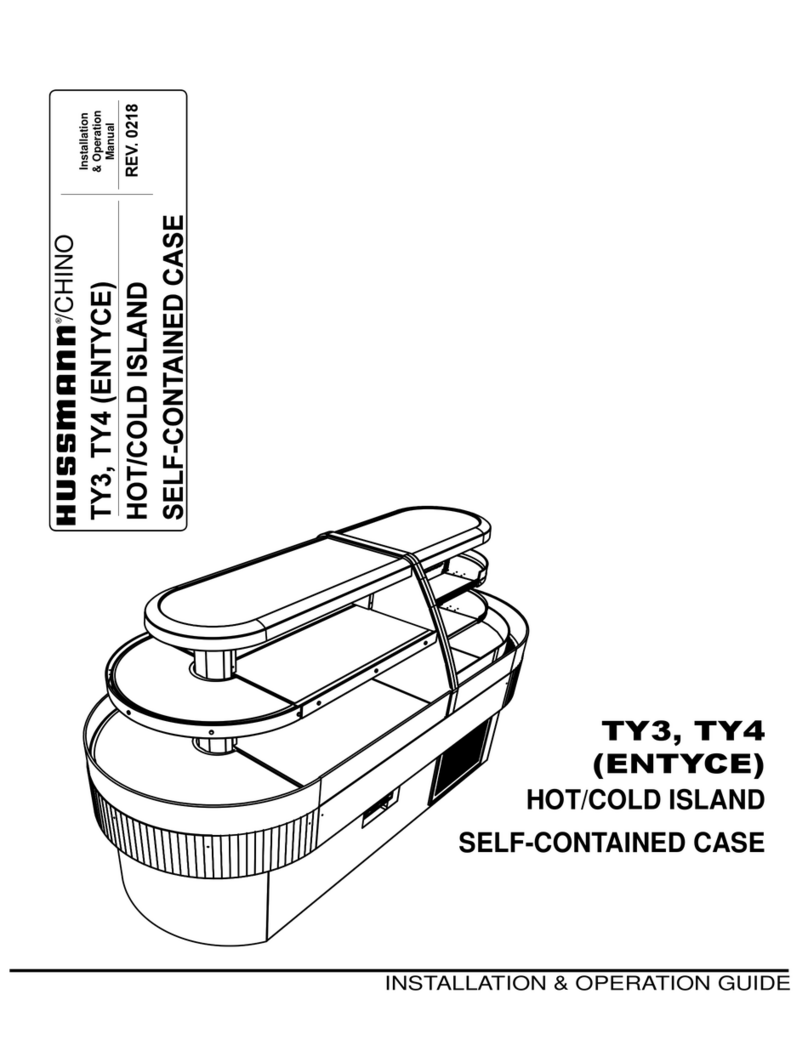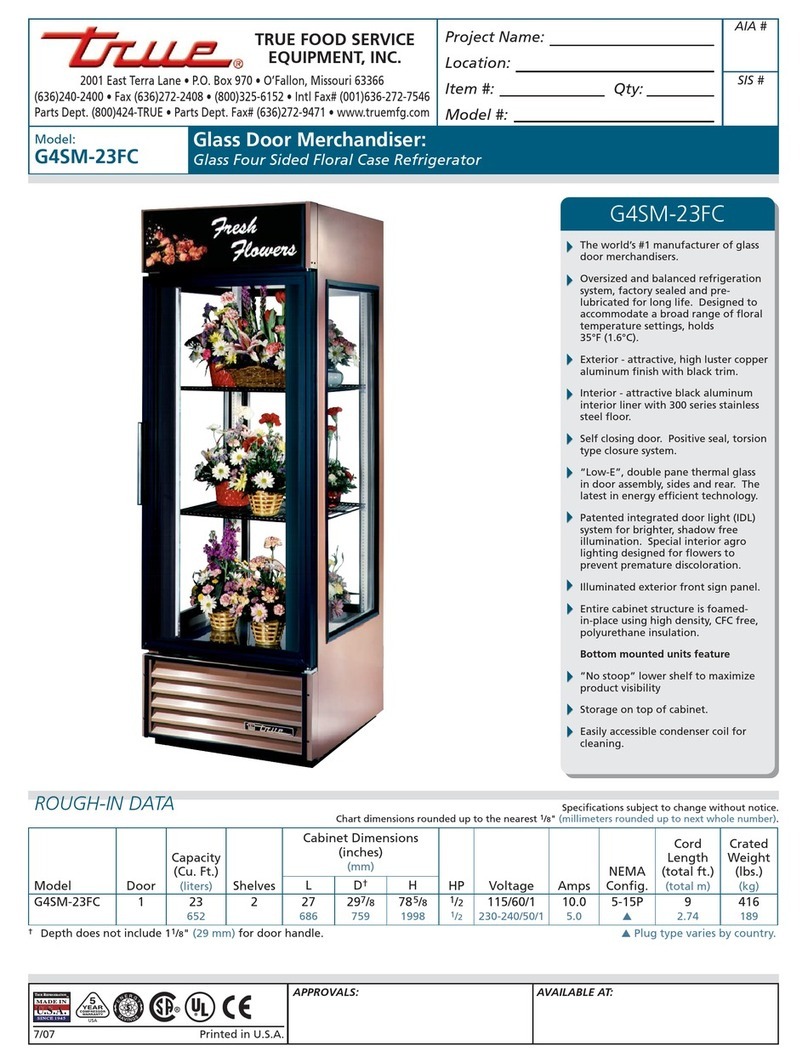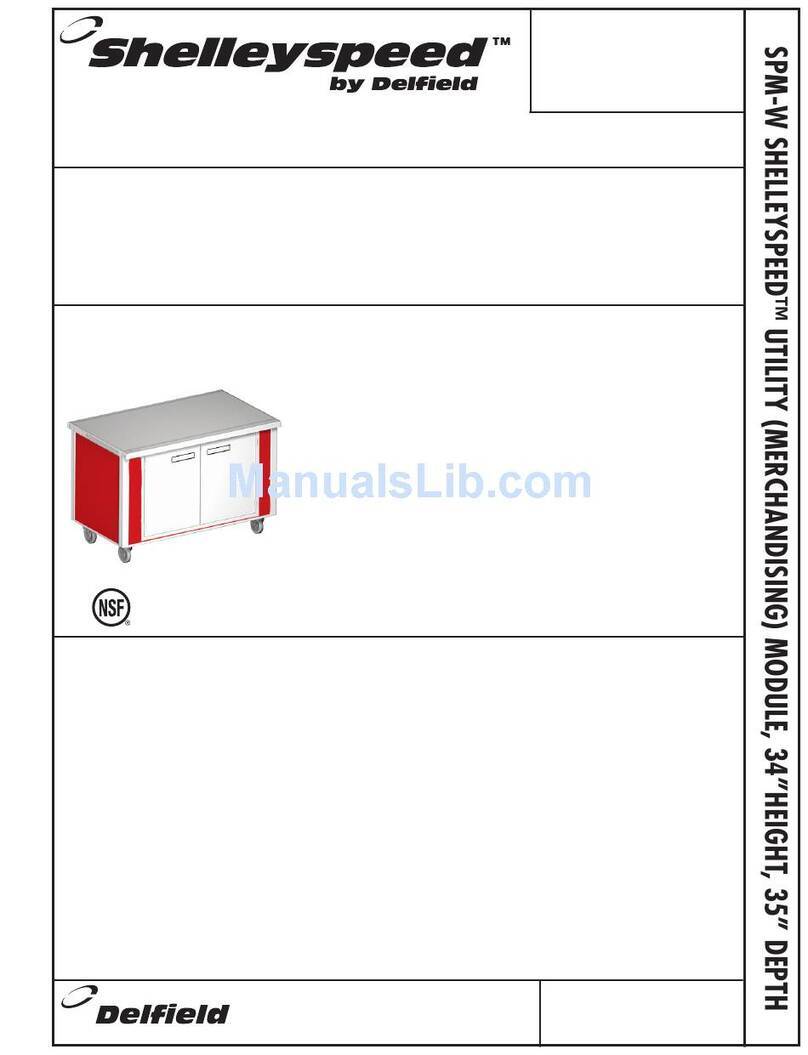Barker AGB User manual

AGB
MEAT/CHEESE
04/16
MULTI-DECK MERCHANDISER
I N S TA L L AT I O N & O P E R AT I O N S M A N U A L
Energy Data & Case Dimensions .......................2-4
General Information ............................................... 5
Installation ..........................................................6-7
Case Connections ...............................................8-9
Lighting and Power Supplies ......................... 10-11
Pre-Power Checklist ............................................12
Airflow & Defrost ..................................................13
Case Cleaning ................................................ 14-15
Parts Ordering ......................................................16
Appendices
Table of Contents
To ensure proper functionality and optimum performance, it is STRONGLY recommended that Hillphoenix specialty cases be installed/serviced by qualified
technicians who have experience working with commercial refrigerated display merchandisers and storage cabinets. For a list of Hillphoenix-authorized
installation/service contractors, please visit our Web site at www.hillphoenix.com.

ii

R-744 (CO2) NOTICE
For Systems Utilizing R-744 (CO2) Refrigerant
For refrigeration units that utilize R-744 (CO2), pressure relief and pressure-regulating relief valves may need
to be installed based on the system capacity. The valves need to be located such that no stop valve is posi-
tioned between the relief valves and the parts or section of the system being protected.
When de-energizing refrigeration units containing R-744 (CO2), venting of the R-744 (CO2) refrigerant may
occur through the pressure regulating relief valves. These valves are located on the refrigeration system
and not on the case model. If venting does occur, the valve must not be defeated, capped, or altered by any
means.
WARNING: Under no circumstances should any component be replaced or added without consulting
Hillphoenix Field Service Engineering. Utilizing improper components may result in serious injury to
persons or damage to the system.
LIABILITY NOTICE
For Cases with Shelf Lighting Systems
Hillphoenix does NOT design any of its shelf lighting systems or any of its display cases with shelf lighting
systems for direct or indirect exposure to water or other liquids. The use of a misting system or water hose
on a display case with a shelf lighting system, resulting in the direct or indirect exposure of the lighting
system to water, can lead to a number of serious issues (including, without limitation, electrical failures,
fire, electric shock, and mold) in turn resulting in personal injury, death, sickness, and/or serious property
damage (including, without limitation, to the display itself, to the location where the display is situated
[e.g., store] and to any surrounding property). DO NOT use misting systems, water hoses or other devices
that spray liquids in Hillphoenix display cases with lighted shelves.
If a misting system or water hose is installed or used on a display case with a shelf lighting system, then
Hillphoenix shall not be subject to any obligations or liabilities (whether arising out of breach of contract,
warranty, tort [including negligence], strict liability or other theories of law) directly or indirectly resulting
from, arising out of or related to such installation or use, including, without limitation, any personal injury,
death or property damage resulting from an electrical failure, fire, electric shock, or mold.
P079211M, REVO
iii

Important
D A N G E R
▲
Indicates an immediate threat of death or seri-
ous injury if all instructions are not followed
carefully.
At Hillphoenix®, the safety of our customers and employees, as well as the ongo-
ing performance of our products, are top priorities. To that end, we include impor-
tant warning messages in all Hillphoenix installation and
operations handbooks, accompanied by an alert symbol paired with the word
"DANGER", "WARNING", or "CAUTION".
All warning messages will inform you of the potential hazard; how to reduce the
risk of case damage, personal injury or death; and what may happen if the in-
structions are not properly followed.
W A R N I N G
Indicates a potential threat of death or serious
injury if all instructions are not followed care-
fully.
▲
C A U T I O N
Indicates that failure to properly follow instruc-
tions may result in case damage.
▲
iv

Revision History
• new manual format_08/12
• parts list_09/12
• energy data and parts list_01/13
• endviews_03/13
• text update and airflow diagram_06/13
• energy data_07/13
• energy data_02/14
• endviews and energy data_09/14
• support diagram and parts page_02/15
• energy data and warranty_04/16
v

AGB REMOTE GRAVITY
ENERGY DATA
Numbers are based on standard case sizes. Consult engineering.
All measurements are taken per ARI 1200 - 2002 specifications.
Engineered for stores with ambient conditions not to exceed 75o and 55% relative humidity.
Due to engineering improvements specifications may change without notice.
Electrical Data
Lighting Data
Guidelines & Control Settings (DX)
Guidelines & Control Settings (Glycol)
Model
Fans
per
Case
High Efficiency
Fans
Anti-Condensate
Fans
Drain
Heaters
Optional Defrost
Heaters Humidification2
120 Volts 120 Volts 120 Volts 208 Volts 120 Volts
Amps Watts Amps Watts Amps Watts Amps Watts Amps Watts
AGB 4’ - - - - - - - - - - - - - - - - - - - - - - - - - - - - - - - - -
6’ - - - - - - - - - - - - - - - - - - - - - - - - - - - - - - - - -
8’ - - - - - - - - - - - - - - - - - - - - - - - - - - - - - - - - -
Model
Lights
per
Row
Light
Length
(ft)
Fluorescent
Lighting
(Per Light Row)
Clearvoyant LED Lighting
(Per Light Row)
Standard Power
(Cornice or Shelf)
High Power
(Cornice)
120 Volts 120 Volts 120 Volts
Amps Watts Amps Watts Amps Watts
AGB 4’ 1 4 0.27 32.4 0.24 30 - - - - - -
6’ 1 4 0.27 32.4 0.24 30 - - - - - -
8’ 1 4 0.27 32.4 0.24 30 - - - - - -
Model
Conventional
4BTUH/ft
Parallel
5BTUH/ft
Superheat
Set Point @ Bulb
(oF)
Evaporator
(oF)
Discharge
Air
(oF)
Discharge Air7
Velocity
(FPM)
AGB Gravity Coil 1527 500 12 15 28 - - -
Serpentine 255 50 8-10 336- - - - - -
RRS3255 200 8-10 - - - 28 - - -
Model
Conventional
BTUH/ft
Parallel
BTUH/ft Supply Temp. (oF)
Flow Rate
GPM/ft
Charge
GAL/ft
Cut-In
Temp (oF)
Cut-Out
Temp (oF)
AGB Gravity Coil 1527 500 20 0.8 0.5 - - - - - -
Serpentine 255 50 20 0.1 0.5 - - - - - -
RRS 255 200 20 0.1 0.5 28 26
2

ENERGY DATA
Numbers are based on standard case sizes. Consult engineering.
All measurements are taken per ARI 1200 - 2002 specifications.
Engineered for stores with ambient conditions not to exceed 75o and 55% relative humidity.
Due to engineering improvements specifications may change without notice.
Defrost Controls
AGB REMOTE GRAVITY
1 NOTE: “- - -” indicates data not applicable.
2 Optional humidification system available to boost humidity. Humidity levels are determined by store aged beef programs.
3 RRS - Refrigerated Rear Storage.
4,5 Listed BTUH indicates unlighted shelves. Add the following for lighted shelves:
4’ Fluorescent: 80 BTUH
3’ Fluorescent: 60 BTUH
4’ Shelf LED: 36 BTUH
4’ Canopy LED: 72 BTUH
3’ Shelf LED: 27 BTUH
3’ Hi-Output LED: 54 BTUH
6 EPR valve is factory installed.
7 Average discharge air velocity at peak of defrost.
8 Defrost is tied to gravity coil.
9 DX units equipped with RH systems require 2 defrosts per day with a fail-safe of 120 minutes.
10 Glycol units equipped with RH systems require 3 defrosts per day with a fail-safe of 120 minutes.
Model
Defrosts9,10
per Day
Run-Off
Time (min)
Electric Defrost Timed-Off Defrost Hot Gas Defrost
Fail-Safe
(min)
Termination
Temp (oF)
Fail-Safe
(min)
Termination
Temp (oF)
Fail-Safe
(min)
Termination
Temp (oF)
AGB Gravity Coil 4 0 - - - - - - 90 47 - - - - - -
Serpentine8- - - - - - - - - - - - - - - - - - - - - - - -
RRS 6 0 - - - - - - 20 47 - - - - - -
3

CASE DIMENSIONS
AGB REMOTE GRAVITY
T8 VERTICAL
LIGHTING
T8 VERTICAL
LIGHTING
2 in
[5.1 cm]
28 in
[71.1 cm]
30 in
[76.2 cm]
6 in
[15.2 cm]
32 in
[81.3 cm]
19 7/8 in
[50.5 cm]
19 7/8 in
[50.5 cm]
20 13/16 in
[52.8 cm]
11 11/16 in
[29.7 cm]
49 13/16 in
[126.5 cm]
30 in
[76.2 cm]
25 13/16 in
[65.6 cm]
21 13/16 in
[55.4 cm]
2 in
[5.1 cm]
34 in
[86.4 cm]
36 in
[91.4 cm]
6 in
[15.2 cm]
32 in
[81.3 cm]
26 13/16 in
[68.1 cm]
11 11/16 in
[29.7 cm]
36 in
[91.4 cm]
31 13/16 in
[80.9 cm]
21 13/16 in
[55.4 cm]
49 13/16 in
[126.5 cm]
93 1/2 in
[237.5 cm]
93 1/2 in
[237.5 cm]
49 1/4 in
[125.1 cm]
49 1/4 in
[125.1 cm]
REFLECTIVE
REAR LOAD DOORS
REFLECTIVE
REAR LOAD DOORS
30" PROFILE 36" PROFILE
48 in
72 in
96 in
[121.9 cm] {4’ case}
[182.9 cm] {6’ case}
[243.8 cm] {8’ case}
28 in [71.1 cm] (30")
34 in [86.4 cm] (36")
26 in [66.0 cm] (30")
32 in [81.3 cm] (36")
TOEKICK
15" x 15" MECHANICAL ACCESS
FOR ELECT. ,REFRIG. ,AND DRAIN CONNECTIONS
TOEKICK
L
C
FRONT OF CASE
18 in
[45.7 cm]
14 in
[35.6 cm]
30 in [76.2 cm]
36 in [91.4 cm]
6 in
[15.3 cm]
POWER SUPPLY
2 in
[5.1 cm]
25 7/8 in
[65.7 cm]
25 7/8 in
[65.7 cm]
LOWER STORAGE WITH
REAR LOAD DOORS
LOWER STORAGE WITH
REAR LOAD DOORS
4

Hillphoenix Barker Specialty Products
703 Franklin Street, PO Box 478
Keosauqua, IA 52565
Tel: (319) 293-3777/Fax: (319) 293-3776
Web site: www.hillphoenix.com
GENERAL INFORMATION
Thank you for choosing Hillphoenix for your food merchandising needs. This handbook contains important technical information
and will assist you with the installation and operation of your new Hillphoenix specialty cases. By closely following the instruc-
tions, you can expect peak performance; attractive fit and finish; and long case life.
We are always interested in your suggestions for improvements (e.g. case design, technical documents, etc.). Please feel free to
contact our Marketing Services group at the number listed below. Thank you for choosing Hillphoenix, and we wish you the very
best in outstanding food merchandising.
CASE DESCRIPTION
This manual specifically covers the AGB-RG aged meat and
cheese application, service multi-deck merchandiser.
STORE CONDITIONS
Hillphoenix cases are designed to operate in an air-condi-
tioned store that maintains a 75°F (24°C) store temperature
and 55% (max) relative humidity (ASHRAE conditions). Case
operation will be adversely affected by exposure to excessively
high ambient temperatures and/or humidity.
REFRIGERATION SYSTEM OPERATION
Air-cooled condensing units require adequate ventilation for
efficient performance. Machine-room temperatures must be
maintained at a minimum of 65°F in winter and a maximum
of 95°F in summer. Minimum condensing temperatures
should be no less than 70°F.
SHIPPING CASES
Transportation companies assume all liability from the time a
shipment is received by them until the time it is delivered to
the consumer. Our liability ceases at the time of shipment.
RECEIVING CASES
Examine fixtures carefully and in the event of shipping dam-
age and/or shortages, please contact the Service Parts
Department at the number listed below.
CASE DAMAGE
Claims for obvious damage must be 1) noted on either the
freight bill or the express receipt and 2) signed by the carrier's
agent; otherwise, the carrier may refuse the claim. If damage
becomes apparent after the equipment is unpacked, retain all
packing materials and submit a written request to the carrier
for inspection within 14 days of receipt of the equipment.
Failure to follow this procedure will result in refusal by the
carrier to honor any claims with a consequent loss to the
consumer.
If a UPS shipment has been damaged, retain the damaged
material, the carton and notify us at once. We will file a
claim.
LOST/MISSING ITEMS
Equipment has been carefully inspected to insure the highest
level of quality. Any claim for lost/missing items must be
made to Hillphoenix within 48 hours of receipt of the equip-
ment. When making a claim please use the number listed
below.
SERVICE & TECHNICAL SUPPORT
For service or technical questions regarding specialty cases,
please contact our Specialty Products Division Service
Department at 1-319-293-3777. For questions regarding our
refrigeration systems or electrical distribution centers, please
contact our Systems Division Customer Service Department at
1-770-388-0706.
CONTACTING THE FACTORY
If you need to contact Hillphoenix regarding a specific fixture,
be certain that you have both the case model number and
serial number (this information can be found on the data tag,
located on the top-left interior of the case). When you have
this information, call the number below and ask for a Service
Parts Representative.
5

CASE INSTALLATION
FLOOR PREP
1. Ask the general contractor if your current copy of the build-
ing dimensions are the most recently issued. Also, ask for
the points of reference from which you should take dimen-
sions to locate the cases.
2. Using chalk lines or a laser transit, mark the floor where
the cases are to be located for the entire lineup. The lines
should coincide with the outside edges of the case feet.
3. Move case as close as possible to its permanent location.
Remove all crating and shipping braces above the ship-
ping pallet. Loosen the plastic dust cover from the pallet,
but leave cover over the case to protect it while removing
the case from the pallet. Carefullly, lift case up and off the
pallet. Remove dust cover. Istallation hardware ships in a
marked packet located inside the case.
4. Leveling is necessary to ensure proper operation of the
refrigeration system and drainage of the condensate.
Locate the highest point on the positioning lines as a ref-
erence for determining the proper height of the shim-pack
levelers. A laser transit is recommended for precision and
requires just one person. Level adjustable feet by twisting,
if appliacble, or shim as necessary under vertical supports
as this will help ensure that the case is not settling over
time.
5. Locate horizontal support (Fig. 1) positions along the chalk
line. Spot properly leveled shim packs at each support
location.
LINE-UP & INSTALLATION
Single Case
1. Move the case into position, leaving a minimum of 2"
between the wall and back of case. Using a “J” bar, raise
the end of the case (under cross support), and lower the
horizontal support on to the shim packs. Repeat on the
other end of the case.
LOCATION
This refrigerated display case has been designed for displaying
and storing perishable food product. It is engineered for air-
conditioned stores with a maximum ambient of 75°F and 55%
relative humidity.
When selecting the location for placement of this case, avoid
the following conditions:
Excessive Air Movement
1. Doors
2. Air-conditioned vents
3. Other air sources
Excessive Heat
1. Windows
2. Sun
3. Flood lamps 8 feet or less from the product
4. Other heat sources
C A U T I O N
Locate the horizontal supports under unit before
removing from pallet. Failure to do so will dam-
age the finished metal if correct lift points are
not identified prior to removal.
▲
C A U T I O N
These cases are not designed for excessive
external weight. Do not walk on top or inside
of cases. Doing so may result in case damage
and/or personal injury.
▲
W A R N I N G
Be certain that your hands and feet are out of
the way before lowering the case. Failure to do
so may result in serious injury.
▲
Fig. 1 Horizontal supports
SUPPORTS
2. Once the case is properly placed on the shim packs,
check the vertical plumb of the case by placing a bubble
level on the rear wall. Add/remove shim packs as needed.
For the horizontal level, repeat this process after placing
the bubble level on the front sill.
3. Bolt the horizontal base brackets to the bottom outside-
front and back of both line-up cases (Fig. 2). Repeat this
with the domino brackets to the top of the cases ensuring
that brackets are fastened to both cases securely (Fig. 3).
4. Properly align the front panels as needed, then install, if
applicable, front panel trim (supplied).
5. Install the bumper, if applicable, into pre-attached bumper
6

CASE INSTALLATION
Fig. 2 Horizontal base bracket
Fig. 3 Domino bracket
BOLT
DOMINO
track and snap into place.
6. After sufficient time has passed to allow for bumper
shrinkage, cut away the excess bumper for final fit and fin-
ish. Be certain to use an appropriate cutting tool (tubing-
or PVC-cutter) to ensure a smooth cut.
7. Install case shelves and reconnect lights. Be aware that
differing shelf configurations will affect energy consump-
tion and case performance.
8. Snap toekick back onto the base of case.
C A U T I O N
Installation of 3rd-party materials may result in
diminished case performance.
▲
7

CASE CONNECTIONS
REFRIGERATION
Refrigeration connections will be made through the refrigera-
tion stub up location on the customer left side of the case.
Refrigeration lines may be headed together for all cases in a
line-up, if necessary, by lines through the access holes with a
high grade silicon to prevent recirculation. All lines must be
correctly sized. See diagram on page 9 for access locations.
If it becomes necessary to penetrate the case bottom for any
reason, make certain it is sealed afterward with canned-foam
sealant and white RTV.
ELECTRICAL
Electrical hookups are made through the power supply box
that can be accessed by removing the back panel.
For case-to-case wiring, run conduit between the power supply
boxes or run wiring through the raceway. When connecting to
the power supply on the case, field wiring should exit box from
the side furthest away from case wiring to allow more room in-
side for wiring connections. Always check the data tag located
on left end exterior panel or top interior of the case. The case
must be grounded. For more detailed electrical wiring infor-
mation, see Appendices A1-A2.
C A U T I O N
Be certain that all plumbing connections are
compliant with local codes.
▲
C A U T I O N
Be certain that all electrical connections are
compliant with local codes.
▲
C A U T I O N
Be sure to remove all styrafoam shipping blocks
from piping and refrigerant lines. Failure to do
so may result in case damage.
▲
Fig. 4 "P" trap / drain outlet
PLUMBING
The drain outlet or “P” trap (Fig. 4) is shipped loose with the
case and made from a 1 1/2” PVC pipe. Care should be given
to ensure that all connections are water-tight and sealed with
the appropriate PVC or ABS cement.
Drain lines can be run left or right of the tee with the proper
pitch to satisfy local drainage requirements. When connecting
the PVC to the existing "oor drains be sure to provide as much
downhill slope as possible and avoid long runs of drain lines.
Do not install condensate drains in contact with non-insulated
suction lines in order to prevent condensate from freezing.
Install the 1 1/2# PVC trap, which is provided with the case. All
drains must be trapped.
Before operating the case, be certain to remove the styrafoam
shipping block that protects the plumbing lines during ship-
ping.
C A U T I O N
If any brazing is necessary, place wet rags
around the area to avoid tank damage.
▲
C A U T I O N
Be certain that all piping connections are com-
pliant with local codes.
▲
C A U T I O N
If the shelves are removed from the case or other-
wise not utilized, the shelf setpoint (SAA) must be
raised to 90 oF to prevent the pump from running
when only the shelves are calling for refrigeration.
Failure to do so could result in early pump failure.
▲
8

CASE CONNECTIONS
48 in
72 in
96 in
[121.9 cm] {4’ case}
[182.9 cm] {6’ case}
[243.8 cm] {8’ case}
18 in
[45.7 cm]
14 in
[35.6 cm]
28 in [71.1 cm] (30")
34 in [86.4 cm] (36")
30 in [76.2 cm]
36 in [91.4 cm]
26 in [66.0 cm] (30")
32 in [81.3 cm] (36")
TOEKICK
15" x 15" MECHANICAL ACCESS
FOR ELECT. ,REFRIG. ,AND DRAIN CONNECTIONS
TOEKICK
L
C
FRONT OF CASE
MECHANICAL ACCESS LOCATIONS
9

LIGHTING & POWER SUPPLIES
BALLAST/POWER SUPPLY ACCESS
To gain access to the ballasts or power supplies remove the
panel located above the rear toe kick.
Fig. 7 Positive engagement
GENERAL LIGHTING INFORMATION
Hillphoenix cases are equipped with either T-8 lights or LED
luminaires and feature specially designed light reflectors in the
cornice to improve the illumination of products. Depending on
case configuration, T-8 electronic ballasts or LED power sup-
plies operate both the cornice and shelf lights and are located
above the cornice reflectors.
The lighting system in the electrical raceway has an ON/OFF
switch located at the back exterior of the case. Once cases
have been properly positioned in the store and an electrician
has connected the lighting circuit, the lights may be turned on
to verify that they are connected and functioning properly.
To ensure peak performance, it is advisable to run the lighting
systems only when the store climate control is on and case
refrigeration is started. NOTE: it is highly recommended that
the ambient store temperature not exceed 80°F.
D A N G E R
▲
SHOCK HAZARD
Always disconnect power to case when cleaning,
servicing or con!guring components of the light-
ing system. Failure to do so may result in serious
injury or death.
REPLACING T-8 LIGHTS
1. Unplug T-8 lamp power cords located at the inside-back of
the case below the lamp being replaced (Fig. 5).
2. Carefully seperate the cap from the lamp holder on both
ends of the T-8 lamp (Fig. 6). Simultaneously pull down at
both ends of the old T-8 lamp to remove.
Fig. 5 T-8 light power cords
W A R N I N G
▲
Using improper DC power supplies may damage
the luminaires, resulting in sub-standard opera-
tion and increased chances of safety issues/
injury.
W A R N I N G
▲
Never replace a 24V DC power supply with a T8
or T5 ballast of any kind! Ballasts use alternat-
ing current (AC) instead of direct current (DC)
and operate at a much higher voltage than is
used by this LED system. Doing so will damage
the LED system and increases the chance of
safety issues/injury.
3. Push and snap the new T-8 lamp into place on the lamp
holder. When the T-8 is properly seated, the lamp button
- which secures the T-8 to the lamp holder - will be clearly
visible through the lamp button hole. The cap should be
pushed all the way down (Fig. 7) for positive engagement
indicator.
Fig. 6 T-8 cap and lamp holder
LAMP HOLDER
CAP
10

LIGHTING & POWER SUPPLIES
REPLACING LED LIGHTS
Once store power is connected and the light circuit is ener-
gized, the Clearvoyant LED system should operate without
the need for any significant maintenance for several years.
Should a power supply need to be removed and/or replaced,
turn off the power to the case before proceeding. Be certain
to replace the power supply with genuine Hill PHOENIX parts or
a comparable UL-listed Class-2 rated regulated 24V DC power
supply with 100W output capacity.
SHELF LUMINAIRES
Removing shelf luminaires:
1. Unplug the luminaire.
2. Pinching the latching clips inward at the ends of the lumi-
naire, rotate luminaire up at each end until hooks are free,
then remove.
Re-installing shelf luminaires:
1. Place hook into shelf roll form at shelf front and rotate
rear of luminaire toward the shelf.
2. Depress the rear clip so that luminaire can finish rotation
and until clip engages the shelf bracket.
NON-SHELF LUMINAIRES
Removing non-shelf luminaires:
1. Simultaniously squeeze the plastic clips at each end.
2. When the hooks are disengaged, pull the luminaire free.
Re-installing non-shelf luminaires:
1. Align the 4-pole jack with the 4-pole connector on the clip-
in luminaire.
2. Push into place - side clips will engage on the sheet metal
of the case.
3. Fasten anti-tamper bracket into sheet metal of case with
#8 screw at end opposite of the 4-pole in-line connector
D A N G E R
▲
SHOCK HAZARD
Always disconnect power to case when cleaning,
servicing or configuring components of the light-
ing system. Failure to do so may result in serious
injury or death.
11

PRE-POWER CHECKLIST
Have you thoroughly examined the case for shipping damage? (see pg. 5)
Have you checked the vertical plumb of the case? The horizontal level?
(see pg. 6)
Have you installed the toekick? (see pg. 7)
Have you removed the shipping blocks from the refrigeration and plumbing
lines? (see pg. 8)
After powering-up the case, be certain that all of the steps listed below have
been completed to ensure proper case functionality, safety and compliance with
warranty terms.
1. Check all lights to ensure they are all functioning properly.
2. Check case temperature and adjust controller as needed.
Before powering-up the case, be certain that all of the steps listed below have
been completed to ensure proper case functionality, safety and compliance with
warranty terms.
12

AIRFLOW & DEFROST
AIRFLOW & PRODUCT LOAD
Hillphoenix cases provide maximum product capacity within the
refrigerated air envelope. Please keep products within the ap-
propriate load limit.
It is important that you do not overload the food product display
so that it impinges on the air•ow pattern (Fig. 8). Overload-
ing will cause malfunction and the loss of proper temperature
levels, particularly when discharge and return air sections are
covered.
DEFROST & TEMPERATURE CONTROLS
Cases are equipped with either Electric, Hot Gas, or Timed-Off
defrost at the owner's option.
The hot gas defrost termination sensor bulb and probe are
attached to the dump line which is in the front, left-hand side
of the case.
W A R N I N G
Always keep product within the designated air
curtain. Failure to do so may result in case
malfunction and product losing proper tempera-
ture, resulting in sub-standard operation and
increased chances of food contamination.
!
Fig. 8 Airflow pattern
HUMIDIFICATION SYSTEMS
The starting point for proper humidity levels in the AGB display
case are typically around 75% RH when stocked with product.
The RH will vary during defrost or cycling. A humidification
system is recommended to ensure consistent performance in
all store ambient. Several factors to consider are listed below
and adjustments may need to be made to the setting for par-
ticular configurations to maintain humidity levels within a case.
1. Store Conditions - Hillphoenix cases are designed to oper-
ate in an air-conditioned store that maintains a 75°F
(24°C) store temperature and 55% (max) relative humidity
(ASHRAE conditions). Case operation will be adversely
affected by exposure to excessively high ambient tempera-
tures and/or humidity.
2. Desired Case Temperature - Hillphoenix recommends a
set point of 33˚-36˚F. If the meat is too cold the meat may
freeze and the aging process will slow or stop. If the meat
is too warm it will spoil.
3. Dry Aging Process - Dry aged beef is typically stored for
14-21 days in a humidity and temperature controlled envir-
norment. The productmoisture content, desired shrink and
approximate timespent in the aging process all are factors
related to the amountof humidity the product releases into
the case environment.
All set points and parameters are starting point and
must be adjusted to meet ambient conditions and
desired product temperatures.
If store conditions are very dry, an optional humidification sys-
tem is recommended.
If your case is equipped with a Dixell temperature and humidity
controller, see Appendices B1-B4 for operating instructions.
DETERMINING SUPERHEAT
To identify proper superheat settings, complete the following:
1. Obtain suction pressure from access port; obtain suction
line temperature from area near TXV bulb at the outlet of
evaporator coil.
2. Using the suction pressure reading, convert pressure to
temperature using temperature pressure chart (see
Appendix C1).
3. Finally, subtract the converted temperature reading from
the actual temperature reading for superheat setting.
13

CASE CLEANING
CASE CLEANING
A periodic cleaning schedule should be established to maintain
proper sanitation, insure maximum operating efficiency, and
avoid the corrosive action of food fluids on metal parts that are
left on for long periods of time. We recommend cleaning once
a week. Further suggestions for case cleaning include the fol-
lowing:
• To avoid shock hazard, be sure all electrical power is turned
off before cleaning. In some installations, more than one
disconnect switch may have to be turned off to completely
de-energize the case.
• All surfaces pitch downward to a deep-drawn drain trough,
funneling liquids to the center of the case where the waste
outlet is located for easy access. Check the waste outlet to
insure it is not clogged before starting the cleaning process
and avoid introducing water faster than the case drain can
carry it away.
• To clean the LED luminaires, shut off the lights in the case,
then wipe the luminaires down with a soft, damp cloth.
Avoid using harsh or abrasive cleaners as they may dam-
age the lights. Be certain that the luminaires are complete-
ly dry before re-energizing.
• Clean from top to bottom when cleaning the display case to
avoid cross contamination.
• If any potentially harmful cleaners are used, be certain
to provide a temporary separator (e.g., cardboard, plastic
wrap, etc.) between those cases that are being cleaned
and those that may still contain product.
• Avoid spraying any cleaning liquids directly on the electrical
connections.
• Allow cases to be turned off long enough to clean any frost
or ice from coil and pans.
• Remove toekick and clean underneath the case with a
broom and a long-handled mop. Use warm water and a
disinfecting cleaning solution when cleaning underneath
the cases.
D A N G E R
▲
SHOCK HAZARD
Always disconnect power to case when servicing
or cleaning. Failure to do so may result in serious
injury or death.
W A R N I N G
▲
Exercise extreme caution when working in a case
with the coil cover removed. The coil contains
many sharp edges that can result in severe cuts
to the hands and arms.
14

SOVIS ULTRAVISION®tempered glass specialized Anti-Reflective coatings on each surface of the glass.
These coatings reduce the glare from lighting so that the products on display are more visible to your
customers.
While the Anti-Reflective coatings are durable, they are susceptible to scratching if abrasive materials are
used for cleaning. Once the glass surfaces are scratched, it is impossible to restore the original finish.
Special care must be taken to prevent damage when cleaning the glass. SOVIS recommends the
following products for routine cleaning of ULTRAVISION®Anti-Reflective glass:
Cleaning Cloths – two products are recommended…
Scotch-Brite®High Performance Cloth – manufactured by 3M®and available in most grocery
stores under the name Scotch-Brite®Microfiber Cleaning Cloth in a 12” x 14” size. This cloth is
washable and may be reused as long as it remains clean.
Spontex®Microfibre Cleaning Cloth – distributed by Spontex®and available in most grocery stores
under the same name in a 15.75” x 12” size. This cloth is washable and may be reused as long as it
remains clean.
Cleaning Fluid – for more difficult cleaning jobs, these products are recommended…
Windex®- standard product only (extra-strength or specialty products may not be suitable)
Glass-Plus®- standard product only (extra-strength or specialty products may not be suitable)
Exceed®Multi-Surface & Glass Cleaner – from Kay Chemical Company, Greensboro, NC
Warm Water
Note: equivalent store-brand glass cleaning products are normally acceptable substitutes to the brand
name products listed above.
The cleaning cloths named above will normally remove dust, grease, oil, and fingerprints without the need
for cleaning fluids. A light spray of the cleaning fluids listed above will reduce the time required for
cleaning. These materials have been tested and proven to clean ULTRAVISION®glass without
scratching or damaging the Anti-Reflective coatings. If you need assistance with obtaining these
materials, please contact your display case supplier.
Under no circumstances should the following types of materials be used for cleaning glass with
ULTRAVISION®Anti-Reflective coatings.
Coarse Paper Towels
Scouring Pads or Powders
Steel Wool or Steel Fiber Materials
Blades
Acidic or highly Alkaline detergents
Fluorine based detergents
THIS DOCUMENT CONTAINS IMPORTANT INFORMATION ABOUT
CLEANING YOUR ULTRAVISION®ANTI-REFLECTIVE GLASS!
PLEASE READ AND FOLLOW THESE INSTRUCTIONS TO
PREVENT DAMAGE TO THE ANTI-REFLECTIVE COATINGS.
C A U T I O N
Do not use these materials for cleaning glass.
▲
CASE CLEANING
15

PARTS ORDERING
Contact the Service Parts Department at:
319-293-3777
Provide the following information about the part you are ordering:
• Model number and serial number* of the case for which the part is intended.
• Length of the part (if applicable).
• Color of part (if painted) or color of polymer part.
• Whether part is for left- or right-hand application.
• Quantity
*Data tag is located on the left end exterior panel or top interior of the case.
If the parts are to be returned for credit, contact the Parts Department. Do not send parts without
authorization.
16
Table of contents
Other Barker Merchandiser manuals
Popular Merchandiser manuals by other brands
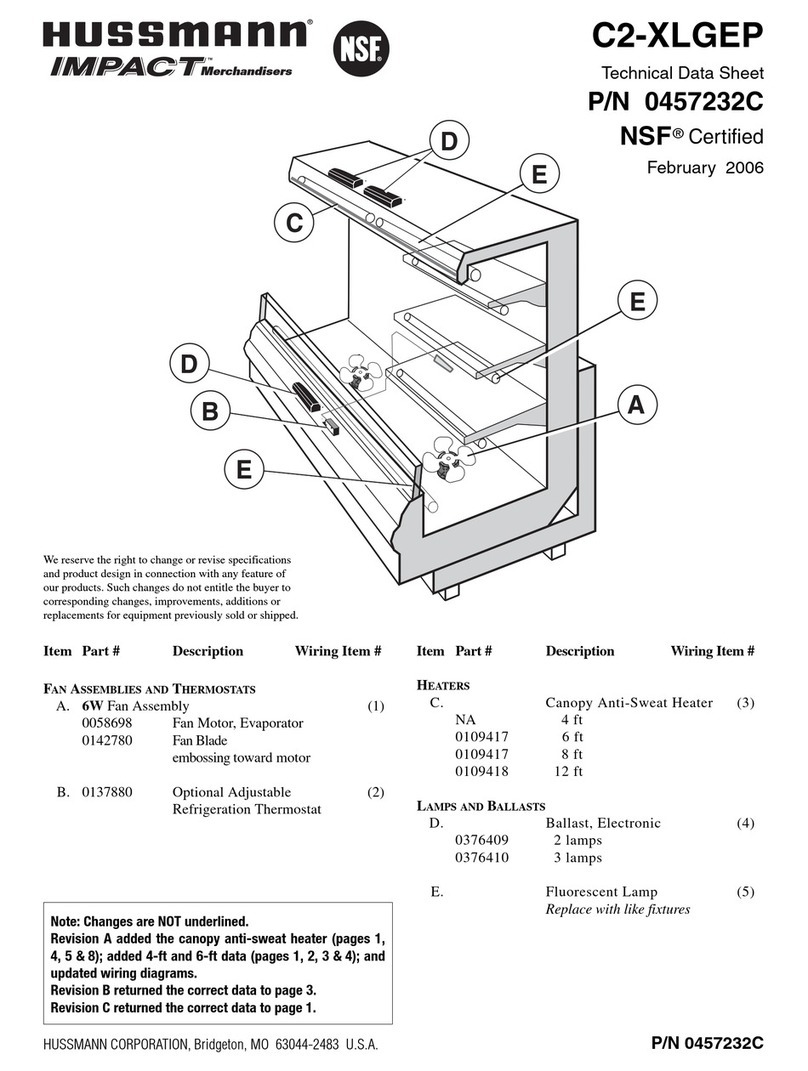
Hussmann
Hussmann Impact Excel C2X-LGEP Technical data sheet
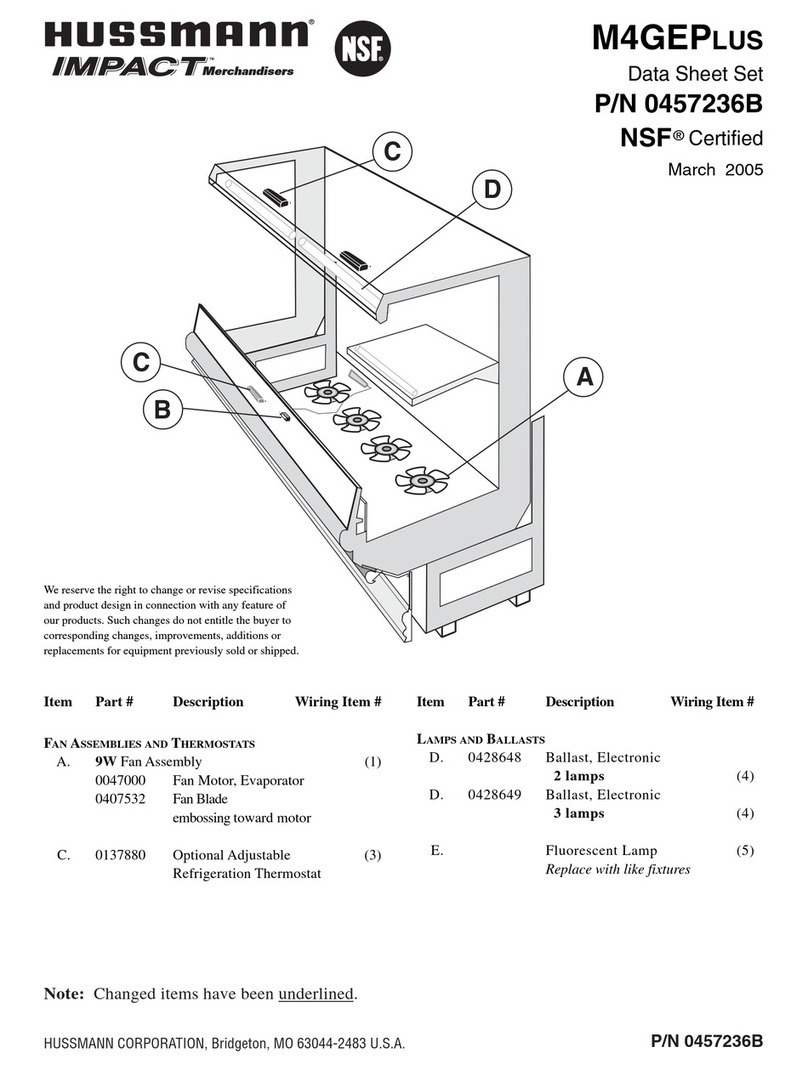
Hussmann
Hussmann M4G-EP datasheet
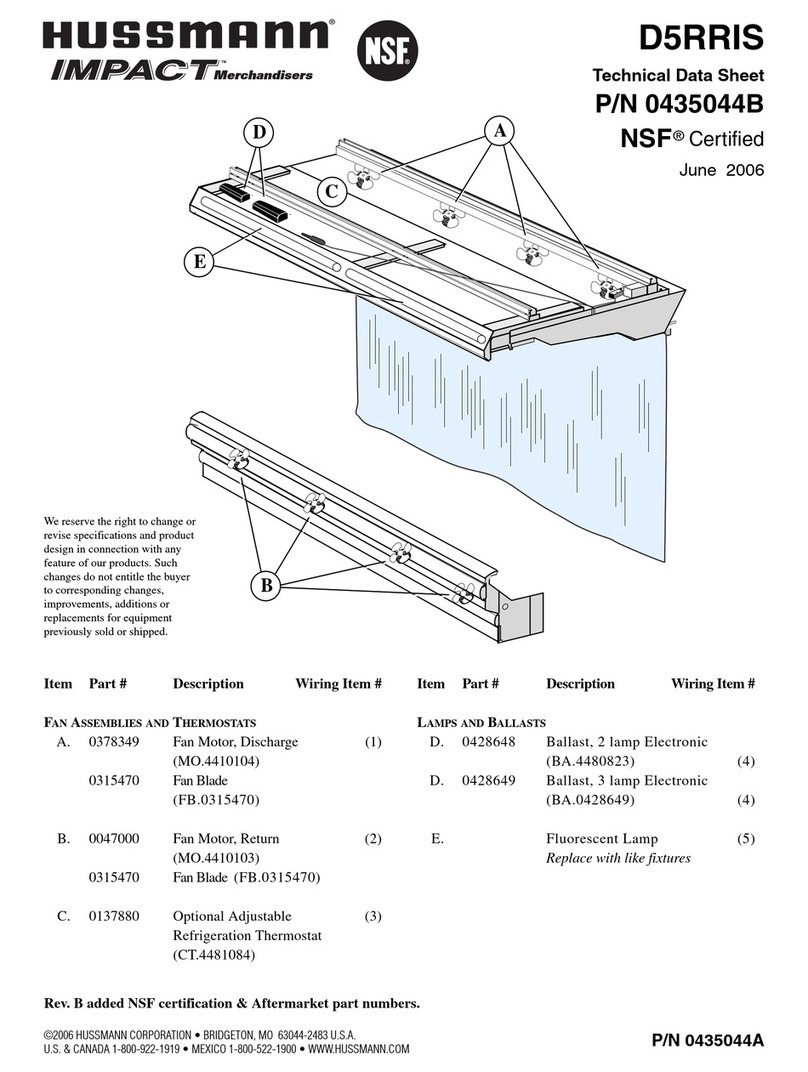
Hussmann
Hussmann IMPACT D5RRIS Technical data sheet
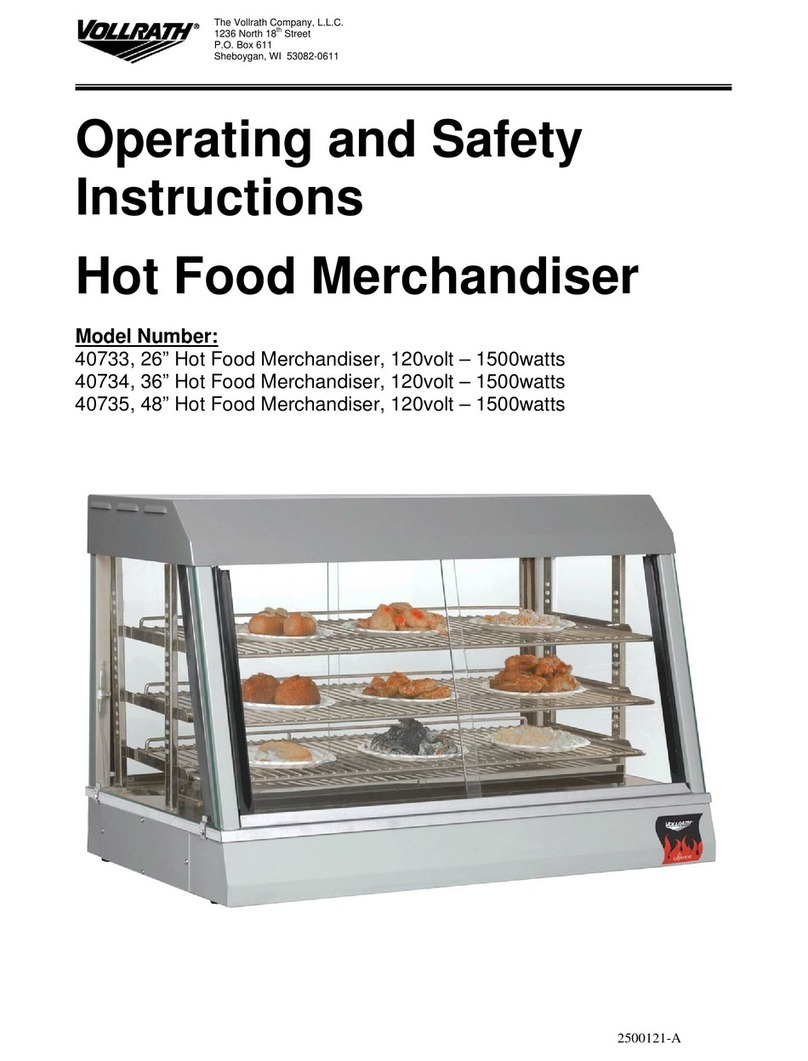
Vollrath
Vollrath 40733 Operating and safety instructions

Avantco
Avantco 178GDW23BB user manual
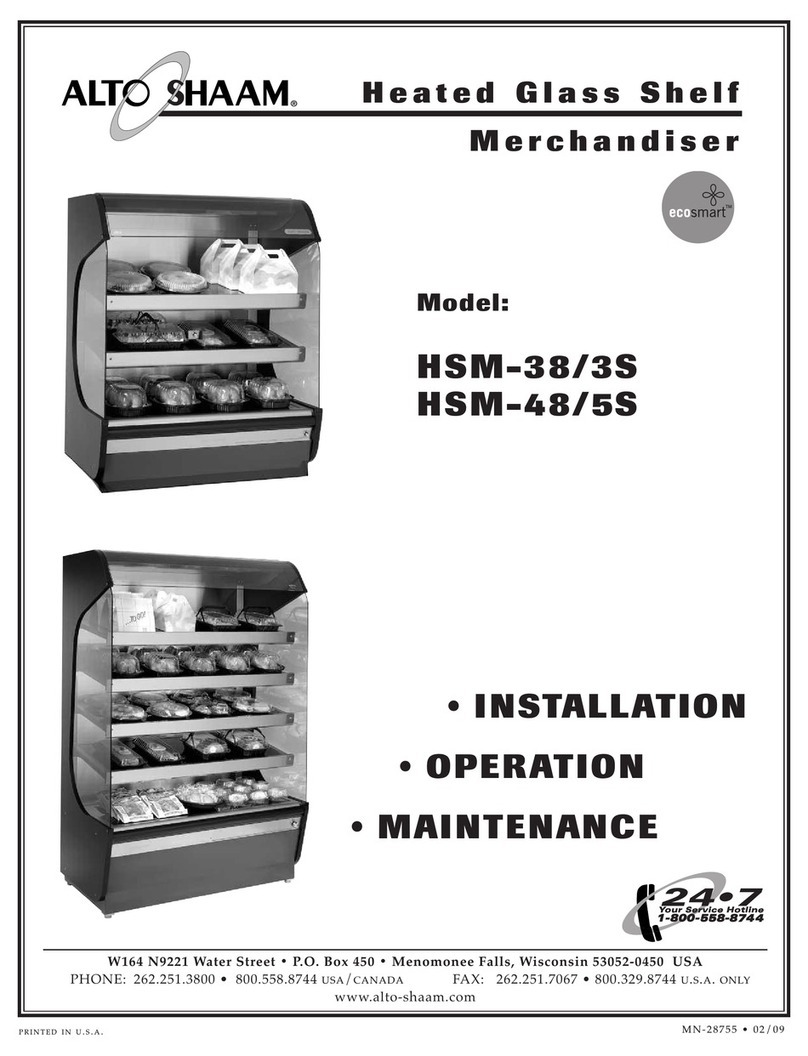
Alto-Shaam
Alto-Shaam HSM-38/3S Installation operation & maintenance

Alto-Shaam
Alto-Shaam HSM-38/3S Specification sheet
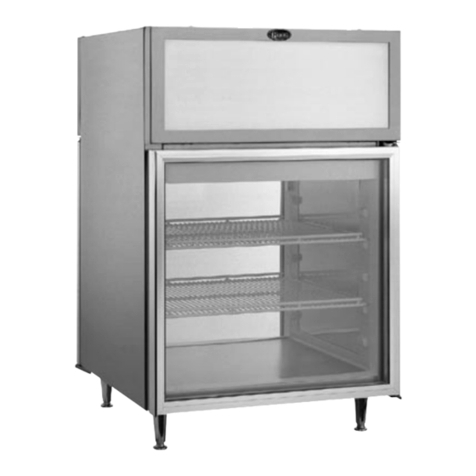
Randell
Randell 40024 Series Specifications

Hatco
Hatco GLO-RAY GR3SDS-39DCT Installation and operating manual
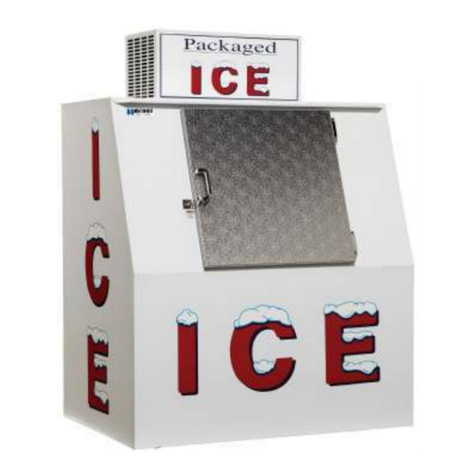
Master Bilt
Master Bilt IM-38 Installation and operation manual
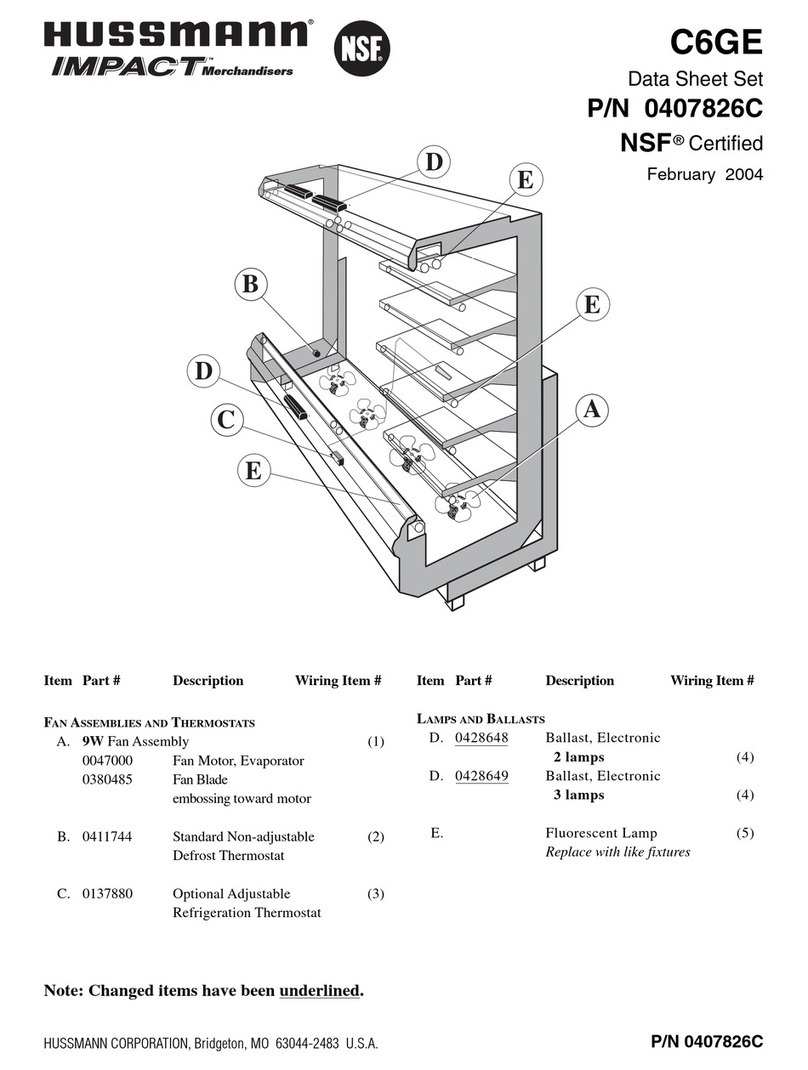
Hussmann
Hussmann Impact C6GE datasheet
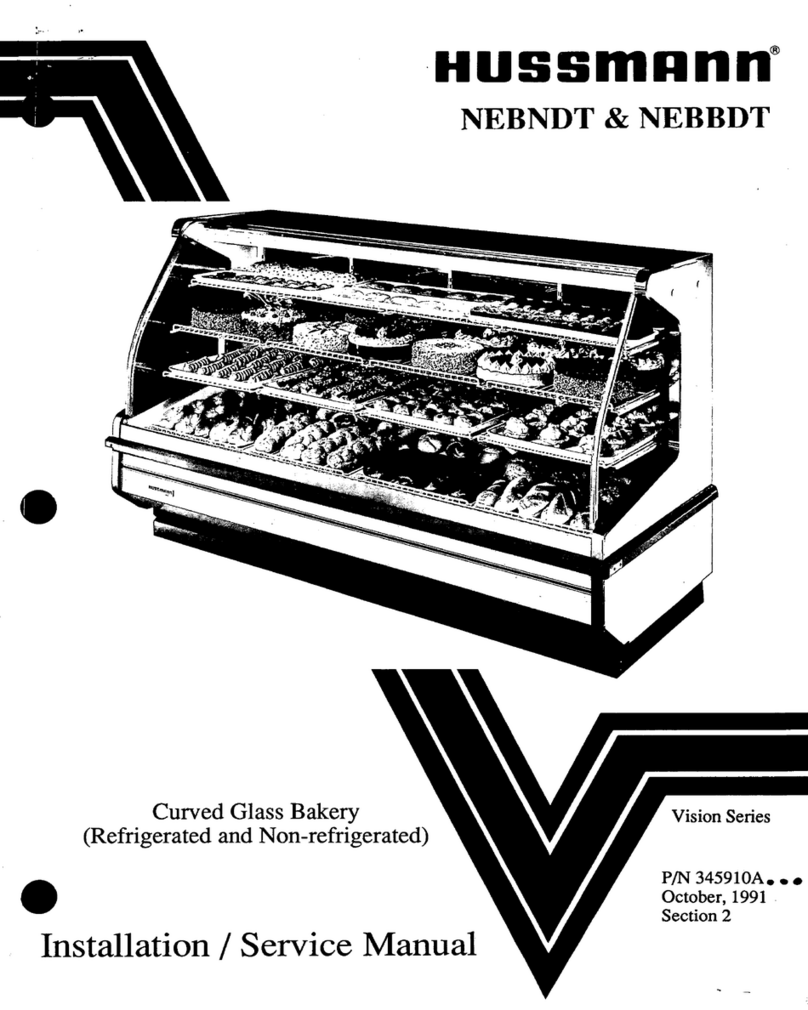
Hussmann
Hussmann NEBBDT Installation & service manual
